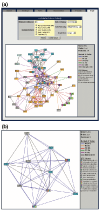Prolinks: a database of protein functional linkages derived from coevolution
- PMID: 15128449
- PMCID: PMC416471
- DOI: 10.1186/gb-2004-5-5-r35
Prolinks: a database of protein functional linkages derived from coevolution
Abstract
The advent of whole-genome sequencing has led to methods that infer protein function and linkages. We have combined four such algorithms (phylogenetic profile, Rosetta Stone, gene neighbor and gene cluster) in a single database--Prolinks--that spans 83 organisms and includes 10 million high-confidence links. The Proteome Navigator tool allows users to browse predicted linkage networks interactively, providing accompanying annotation from public databases. The Prolinks database and the Proteome Navigator tool are available for use online at http://dip.doe-mbi.ucla.edu/pronav.
Figures






References
Publication types
MeSH terms
Substances
LinkOut - more resources
Full Text Sources
Other Literature Sources
Molecular Biology Databases

